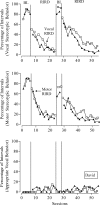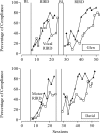Further evaluation of response interruption and redirection as treatment for stereotypy
- PMID: 21541130
- PMCID: PMC3050456
- DOI: 10.1901/jaba.2011.44-95
Further evaluation of response interruption and redirection as treatment for stereotypy
Abstract
The effects of 2 forms of response interruption and redirection (RIRD)-motor RIRD and vocal RIRD-were examined with 4 boys with autism to evaluate further the effects of this intervention and its potential underlying mechanisms. In Experiment 1, the effects of motor RIRD and vocal RIRD on vocal stereotypy and appropriate vocalizations were compared for 2 participants. In Experiment 2, the effects of both RIRD procedures on both vocal and motor stereotypy and appropriate vocalizations were compared with 2 additional participants. Results suggested that RIRD was effective regardless of the procedural variation or topography of stereotypy and that vocal RIRD functioned as a punisher. This mechanism was further explored with 1 participant by manipulating the schedule of RIRD in Experiment 3. Results were consistent with the punishment interpretation.
Keywords: automatic reinforcement; punishment; response interruption and redirection; stereotypy.
Figures





References
-
- Bodfish J.W, Symons F.J, Parker D.E, Lewis M.H. Varieties of repetitive behavior in autism: Comparisons to mental retardation. Journal of Autism and Developmental Disorders. 2000;30:237–243. - PubMed
-
- Britton L.N, Carr J.E, Landaburu H.J, Romick K.S. The efficacy of noncontingent reinforcement as treatment for automatically reinforced stereotypy. Behavioral Interventions. 2002;17:93–103.
MeSH terms
LinkOut - more resources
Full Text Sources

